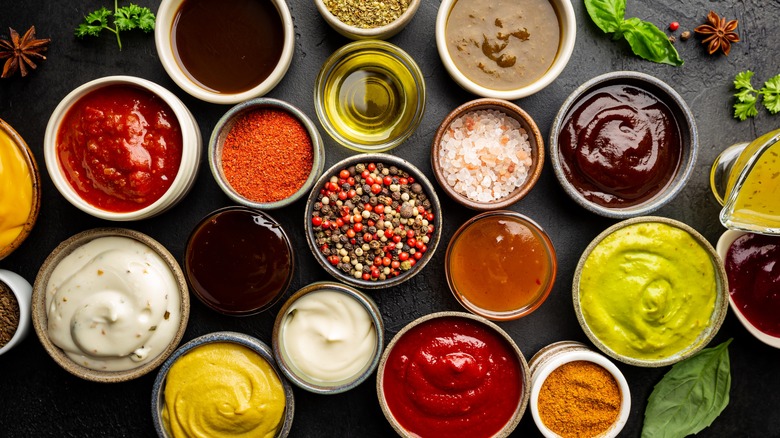The Old-School Condiment That Went Out Of Fashion In Restaurants
We may receive a commission on purchases made from links.
Imagine restaurant condiments and standard bottles of Tabasco, ketchup, and mayo come to mind. Yet, if you were to dine at an upscale eatery in the early 20th century, you might have encountered mint jelly, too. The now out-of-style condiment traditionally accompanies hearty lamb recipes, flavoring meats with a diverse array of notes. Most modern versions tend to taste sweet — some more mint-forward and tart — while now outdated recipes even mixed in lamb broth for a fully savory rendition.
Like other preserves, you'll most often find mint jelly in a jar, ready to serve by the spoonful. Yet, for a more eye-catching presentation, 20th-century cooks occasionally cubed the jelly for use as a topping, or even cast it into a mold for intricate, decorative shapes. Furthermore, many mint jellies continue to employ green food coloring to enhance their striking appearance.
Mint jelly is a tasty condiment, prepared with a balanced palate that bridges sweet and savory contexts. Some cooks still craft this preserve at home, and you can easily buy a jar online, such as the well-rated Stonewall Kitchen Classic Mint Jelly. Although the condiment has gradually faded from restaurant menus and disappeared into obscurity since the 1960s, its fundamental flavor pairing remains highly prevalent in modern cooking. This is evident in recipes like fennel and mint-marinated lamb or easy lamb lettuce wraps served with a bright mint yogurt.
British mint sauce inspired the sweet-savory American jelly
Before mint jelly came mint sauce, a more savory and liquid creation consumed in the United Kingdom for centuries. Long designated for lamb, recipes dating as far back as the 19th century called for combining the herb with sugar and vinegar — both effective preservatives. The lamb-mint combination then spread to the U.S. in the early 20th century, a popular era for jelly recipes.
Accordingly, mint jelly preserves also took on an increasingly blurred sweet-and-savory composition. Much like its British precursor, some recipes still liberally use vinegar, employing less sugar. Others opt for a sweeter composition, with only a touch of lemon for acid. And whether ginger or spicy peppers, other aromatic spices are certainly welcome in the mix, too. Dependably, recipes for the preserve employ an abundance of mint and use natural or commercial pectin — rather than gelatin — for the congealing effect.
Mint jelly proliferated well into the 1950s, alongside similarly textured creations like aspic, which also often appeared in luxurious contexts. The attitude toward such foods shifted briskly during the mid-20th century, eliminating gelatinous dishes from fine dining. Nevertheless, there is a magic to the pairing: try a serving of lamb and mint jelly for yourself.


